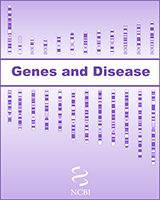NCBI Bookshelf. A service of the National Library of Medicine, National Institutes of Health.
National Center for Biotechnology Information (US). Genes and Disease [Internet]. Bethesda (MD): National Center for Biotechnology Information (US); 1998-.

Fragile X syndrome is the most common inherited form of mental retardation currently known. Fragile X syndrome is a defect in the X chromosome and its effects are seen more frequently, and with greater severity, in males than females.
In normal individuals, the FMR1 gene is transmitted stably from parent to child. However, in Fragile X individuals, there is a mutation in one end of the gene (the 5' untranslated region), consisting of an amplification of a CGG repeat. Patients with fragile X syndrome have 200 or more copies of the CGG motif. The huge expansion of this repeat means that the FMR1 gene is not expressed, so no FMR1 protein is made. Although the exact function of FMR1 protein in the cell is unclear, it is known that it binds RNA.
A similar nucleotide repeat expansion is seen in other diseases, such as Huntington disease. Research in mice has proven helpful in elucidating some of the mechanisms that cause the instability of this gene. Our methods for identifying carriers of Fragile X syndrome have also improved, and further research will help people carrying "premutations" to avoid having children who have a larger expansion (i.e. more CGG repeats) in FMR1, and therefore suffer from Fragile X syndrome.
Related diseases
- Genome view see gene locations
- Entrez Gene collection of gene-related information
- BLink related sequences in different organisms
- Research articles online full text
- Books online books section
- OMIM catalog of human genes and disorders
- GeneReviews a medical genetics resource
- Fact sheet from the National Institute of Child Health and Human Development, NIH
- National Fragile X Foundation US-based research, information and support
- OMIMRelated OMIM records
- Fragile X syndrome - Genes and DiseaseFragile X syndrome - Genes and Disease
- PREDICTED: Cucurbita maxima 30S ribosomal protein S5, chloroplastic-like (LOC111...PREDICTED: Cucurbita maxima 30S ribosomal protein S5, chloroplastic-like (LOC111478601), mRNAgi|1280990378|ref|XM_023122965.1|Nucleotide
Your browsing activity is empty.
Activity recording is turned off.
See more...
